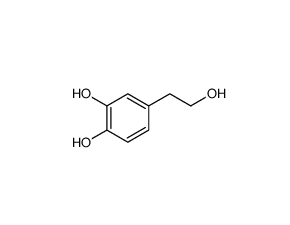
3,4-Dihydroxyphenylethanol
CAS No. 10597-60-1
3,4-Dihydroxyphenylethanol( —— )
Catalog No. M17790 CAS No. 10597-60-1
3, 4-Dihydroxyphenylethanol is an active ingredient extracted from the olive.
Purity : >98% (HPLC)
 COA
COA
 Datasheet
Datasheet
 HNMR
HNMR
 HPLC
HPLC
 MSDS
MSDS
 Handing Instructions
Handing Instructions
| Size | Price / USD | Stock | Quantity |
| 10MG | 41 | In Stock |


|
| 25MG | 60 | In Stock |


|
| 50MG | 80 | In Stock |


|
| 100MG | 130 | In Stock |


|
| 200MG | Get Quote | In Stock |


|
| 500MG | Get Quote | In Stock |


|
| 1G | Get Quote | In Stock |


|
Biological Information
-
Product Name3,4-Dihydroxyphenylethanol
-
NoteResearch use only, not for human use.
-
Brief Description3, 4-Dihydroxyphenylethanol is an active ingredient extracted from the olive.
-
DescriptionHydroxytyrosol is a phenylethanoid, a type of phenolic phytochemical with antioxidant properties in vitro. In nature, hydroxytyrosol is found in olive leaf and olive oil, in the form of its elenolic acid ester oleuropein and, especially after degradation, in its plain form. Hydroxytyrosol itself in pure form is a colorless, odorless liquid. The olives, leaves and olive pulp contain large amounts of hydroxytyrosol (compared to olive oil), most of which can be recovered to produce hydroxytyrosol extracts. However, it was found that black olives, such as common canned variety, containing iron(II) gluconate contained very little of the original hydroxytyrosol, as iron salts are catalysts for its oxidation. Hydroxytyrosol is also a metabolite of the neurotransmitter dopamine. (In Vitro):Hydroxytyrosol (DOPET) shows the inhibition of pro-inflammatory cytokines (TNF-α) and reduces the expression of cyclooxygenase-2 and inducible nitric oxide synthase (iNOS) more than 60%.Hydroxytyrosol (DOPET) modulates the transcription factor NF-κB.Hydroxytyrosol (DOPET) arrests the cell cycle, producing differentiation, apoptosis, or preventing DNA from oxidative stress.
-
In Vitro——
-
In Vivo——
-
Synonyms——
-
PathwayOthers
-
TargetOther Targets
-
RecptorOthers
-
Research AreaOthers-Field
-
Indication——
Chemical Information
-
CAS Number10597-60-1
-
Formula Weight154.16
-
Molecular FormulaC8H10O3
-
Purity>98% (HPLC)
-
SolubilityIn Vitro:?DMSO : 125 mg/mL (810.85 mM)
-
SMILESc1cc(c(cc1CCO)O)O
-
Chemical Name4-(2-Hydroxyethyl)-1,2-benzenediol
Shipping & Storage Information
-
Storage(-20℃)
-
ShippingWith Ice Pack
-
Stability≥ 2 years
Reference
1. Yunden J, et al. Chem Res Toxicol. 2009 May; 22(5): 835–841.
molnova catalog



related products
-
SEA-0400
SEA0400 is a selective inhibitor of the Na+/Ca2+?exchanger.
-
Revdofilimab
Revdofilimab (ABBV-368) is a human IgG1 monoclonal antibody that acts as an agonist against OX40, a TNF receptor superfamily member expressed on activated and memory T cell subsets as well as T regulatory cells .
-
(2E)-3-(3,5-dimethox...
(2E)-3-(3,5-dimethoxyphenyl)-1-(2-methoxyphenyl)prop-2-en-1-one is a chemical compound.



 Cart
Cart
 sales@molnova.com
sales@molnova.com


